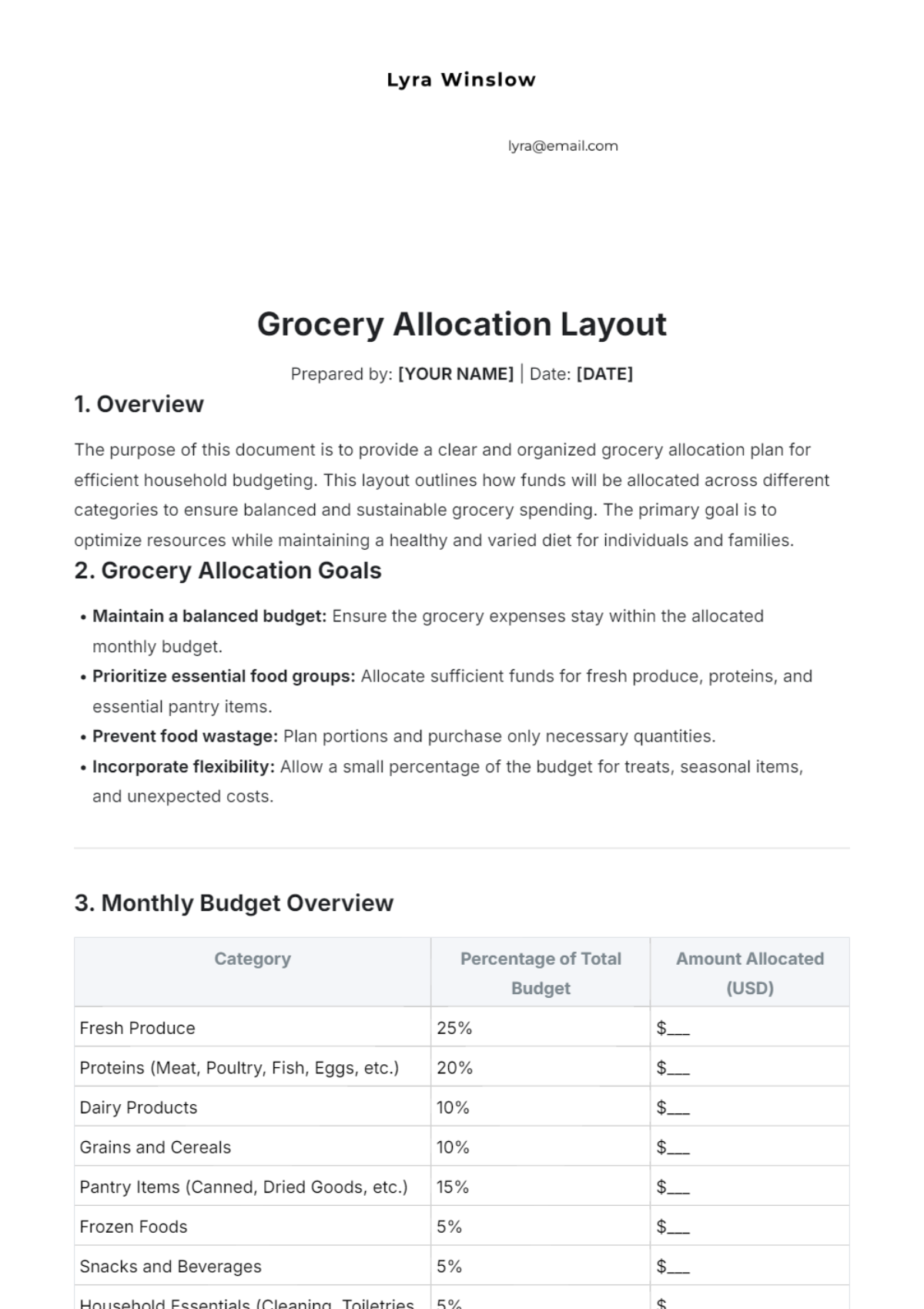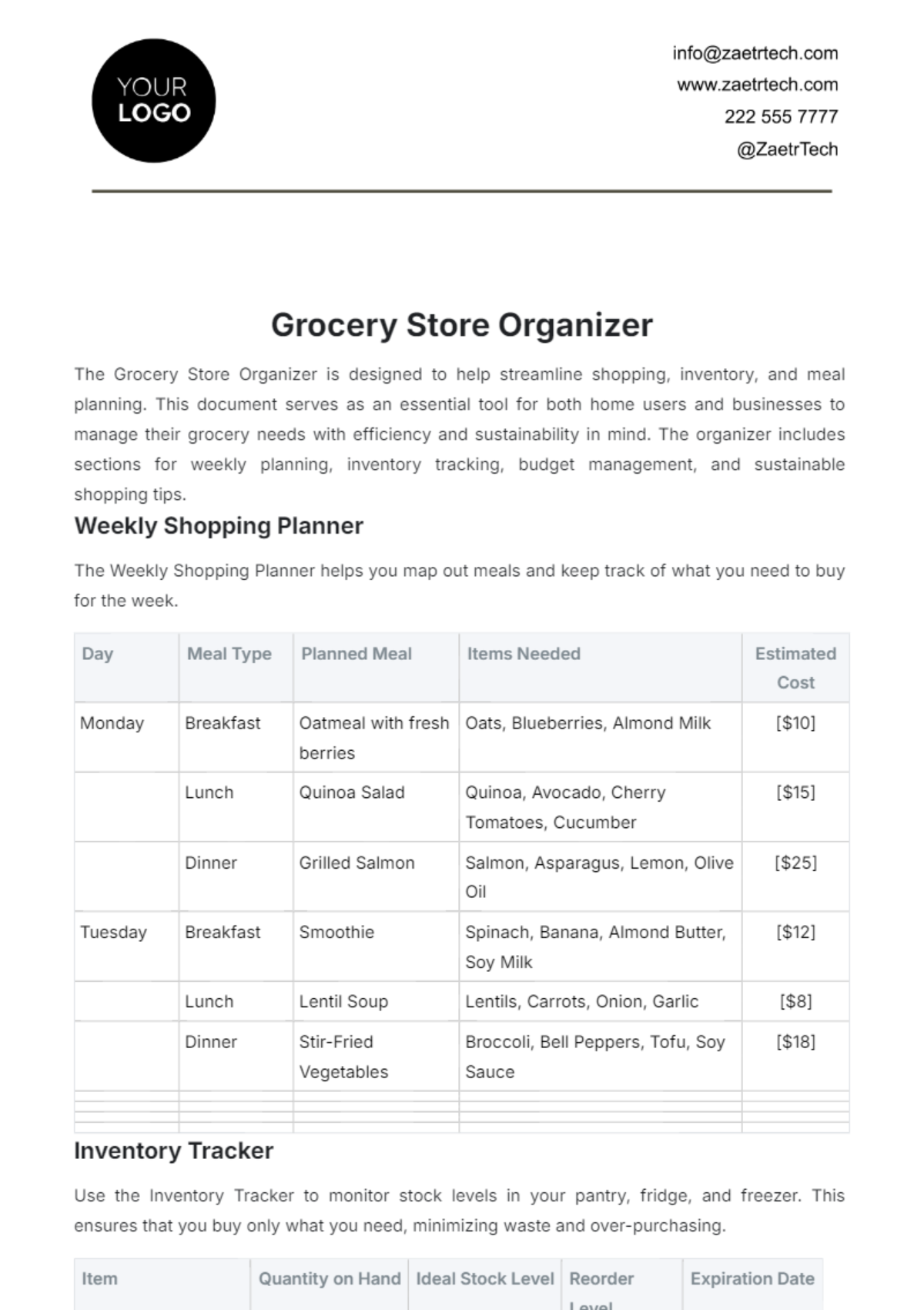Simple Grocery Store Cashier Guideline
I. Introduction
A. Purpose of the Guidelines
1. Objective
The primary objective of these guidelines is to establish clear and detailed instructions for cashiers at [Your Company Name]. These guidelines are designed to ensure that all cashier transactions and customer interactions are handled with consistency, efficiency, and in accordance with the company's standards of accuracy and service. By following these guidelines, cashiers will contribute to a smooth and professional checkout process, enhancing customer satisfaction and supporting the store’s operational goals.
2. Scope
These guidelines apply to all cashiers at [Your Company Name], including full-time, part-time, and seasonal staff. They cover the entire cashiering process, from daily operational tasks to customer service interactions and end-of-day procedures. This comprehensive scope ensures that cashiers have a thorough understanding of their responsibilities and the procedures they need to follow to perform their duties effectively.
3. Overview
This document outlines the essential procedures and protocols for cashiers at [Your Company Name]. It includes detailed sections on opening and closing procedures, customer service standards, transaction handling, security measures, and compliance with store policies. Additionally, the guidelines cover troubleshooting methods, health and safety protocols, and ongoing training requirements, providing a well-rounded resource for cashiers to refer to in their daily operations.
B. Importance of Cashier Guidelines
1. Ensuring Efficiency
Adhering to these guidelines is crucial for maintaining operational efficiency within the store. Efficient transaction processing helps to minimize customer wait times and ensures a smoother flow of business operations. When cashiers follow established procedures, it reduces the likelihood of errors and delays, which contributes to a more streamlined checkout process. Efficient cashiering also supports overall store performance by managing peak hours and high customer traffic effectively.
2. Maintaining Accuracy
Accuracy in transaction handling is vital for preventing errors in pricing, change, and inventory management. By adhering to these guidelines, cashiers can ensure that each transaction is processed correctly, which minimizes financial discrepancies and inventory issues. Accurate transactions also maintain the store’s financial integrity and foster customer trust.
3. Enhancing Customer Experience
Customer service is a key aspect of the cashier role. Positive interactions at the checkout can significantly impact a customer’s perception of the store. By providing friendly and efficient service, cashiers contribute to a pleasant shopping experience that encourages customer loyalty and repeat business. High standards of customer service can also lead to positive word-of-mouth referrals, further enhancing the store’s reputation.
II. Cashier Responsibilities
A. Daily Duties
1. Opening Procedures
Arrival and Preparation
Cashiers should arrive at the store at least 15 minutes before their shift begins. This early arrival allows time to prepare for the day’s operations and address any preliminary tasks.
Upon arrival, check in with the store manager or supervisor to receive any special instructions or updates for the day. This ensures that you are informed of any changes or important information.
Register Setup
Retrieve the register from the secure storage area and set it up for use. Ensure that the register is functioning correctly and that all necessary supplies, such as receipt paper and pens, are readily available.
Verify that the cash drawer contains the correct amount of starting cash as specified by store procedures. This typically includes a predetermined amount of bills and coins for making change throughout the day.
Review Store Promotions
Familiarize yourself with any current promotions, sales, or special offers. This knowledge allows you to accurately apply discounts and inform customers about ongoing deals, enhancing their shopping experience.
2. Customer Interaction
Greeting and Engagement
Greet each customer with a friendly and welcoming demeanor. A positive greeting sets a pleasant tone for the transaction and contributes to a positive customer experience.
Ask customers if they found everything they needed and offer assistance with any questions or issues they may have. This demonstrates attentiveness and enhances customer satisfaction.
Transaction Handling
Scan items accurately, ensuring that each product is correctly entered into the system. Verify prices and apply any relevant discounts or promotions according to current store policies.
Process payments promptly and efficiently, using cash, credit/debit cards, or digital payment methods. Ensure that each payment is processed correctly and that receipts are provided to customers.
Bagging and Loading
Offer to assist with bagging and loading items into the customer’s vehicle if necessary. Providing this additional service can improve the overall customer experience and demonstrate a commitment to excellent service.
B. Customer Service Standards
1. Professionalism
Appearance and Attitude
Maintain a clean and presentable appearance at all times, adhering to the store’s dress code. Proper grooming and attire contribute to a professional image.
Use polite language and maintain a positive attitude, even during busy periods. A courteous demeanor helps to create a welcoming atmosphere and enhances the customer experience.
2. Problem Resolution
Handling Complaints
Listen carefully to customer complaints or issues and address them with empathy and efficiency. Understanding the customer’s perspective and offering solutions can help resolve issues effectively.
Escalate unresolved or complex issues to a supervisor or manager as needed. This ensures that customers receive the appropriate resolution and support.
Return and Exchange Policies
Follow the store’s return and exchange policy to process transactions. Ensure that you are familiar with the specific guidelines for returns and exchanges to handle them correctly.
Properly record returned items and restock them as applicable. This helps to maintain accurate inventory levels and ensures that items are available for other customers.
III. Handling Transactions
A. Cash Transactions
1. Processing Payments
Handling Cash
Count cash carefully to avoid errors. Ensure that you provide accurate change to customers and double-check amounts before handing over money.
Use the register’s cash drawer to store and manage cash securely. Keeping the drawer organized and secure helps prevent theft and loss.
2. Handling Large Denominations
Verifying Large Bills
Verify the authenticity of large bills using counterfeit detection tools. This helps prevent acceptance of counterfeit currency and protects the store’s financial interests.
Record large cash transactions as required by store policy. This provides a clear record of significant cash exchanges and enhances financial accountability.
3. Balancing Cash Drawer
End-of-Day Reconciliation
At the end of your shift, count the cash in the drawer and compare it to the register’s recorded totals. Ensure that the amounts match and investigate any discrepancies.
Report any discrepancies to a supervisor immediately. Documenting and addressing discrepancies promptly helps maintain financial accuracy and accountability.
B. Credit and Debit Card Transactions
1. Processing Cards
Secure Transactions
Swipe or insert credit/debit cards securely, following PCI compliance standards. Ensuring secure processing helps protect sensitive customer information.
Verify signatures or PINs as required by the card issuer. Proper verification helps prevent fraud and unauthorized transactions.
2. Handling Card Issues
Declined Transactions
Address declined card transactions discreetly and professionally. Offer alternative payment methods if a customer’s card is not accepted.
Assist customers in contacting their card issuer if necessary. Providing support in resolving card issues helps maintain a positive customer experience.
3. Preventing Fraud
Monitoring and Reporting
Monitor for suspicious card activity and report any concerns to a supervisor. Identifying and addressing potential fraud helps protect both customers and the store.
Be cautious of card skimming devices and ensure that the register area is secure. Preventative measures help safeguard against fraudulent activities.
C. Digital Payment Methods
1. Processing Mobile Payments
Handling Mobile Transactions
Follow the store’s procedures for accepting mobile payments via apps or digital wallets. Ensure that transactions are processed smoothly and securely.
Confirm successful completion of mobile payments before finalizing the sale. Providing a receipt or transaction confirmation to the customer ensures clarity.
2. Troubleshooting Payment Issues
Addressing Problems
Address issues with digital payments by referring to the store’s troubleshooting guide. This guide provides solutions for common problems and helps maintain smooth operations.
Seek assistance from a supervisor if problems persist. Escalating issues ensures that customers receive the support they need and that transactions are processed correctly.
IV. Security Procedures
A. Register Security
1. Protecting Cash and Assets
Securing the Register
Keep the cash drawer closed and secure when not in use. This prevents unauthorized access and reduces the risk of theft.
Lock the register and any cash storage areas when not in operation. Proper security measures help safeguard store assets and maintain financial integrity.
2. Handling Suspicious Behavior
Reporting Suspicious Activity
Report any suspicious behavior or potential theft to store management immediately. Prompt reporting helps address security concerns and prevent potential losses.
Follow store procedures for handling security incidents. This includes documenting incidents and cooperating with law enforcement if necessary.
B. Personal Security
1. Maintaining Personal Safety
Awareness and Caution
Be aware of your surroundings and avoid engaging with potentially dangerous individuals. Prioritizing personal safety helps prevent confrontations and ensure a secure work environment.
Use the store’s safety protocols if you feel threatened. These protocols provide guidance on how to handle situations that may compromise your safety.
2. Reporting Incidents
Documenting and Reporting
Document and report any security incidents, such as theft or harassment, using the store’s incident report system. Accurate documentation provides a record of events and supports investigation efforts.
Cooperate with law enforcement if necessary. Providing information and assistance helps resolve incidents effectively and supports legal actions.
V. Compliance and Training
A. Adherence to Policies
1. Following Store Policies
Understanding Policies
Familiarize yourself with and adhere to all store policies and procedures. Understanding store guidelines helps ensure compliance and consistency in operations.
Review updates to policies as communicated by store management. Staying informed about policy changes ensures that you are aware of any new requirements or procedures.
2. Regulatory Compliance
Ensuring Compliance
Ensure compliance with relevant local, state, and federal regulations, including those related to labor laws, health, and safety. Adhering to regulations helps avoid legal issues and maintain a safe work environment.
Participate in compliance training sessions as required. These sessions provide important information on regulatory requirements and best practices.
B. Ongoing Training
1. Initial Training
Comprehensive Training Program
Participate in a comprehensive training program upon hiring, covering all aspects of cashier duties and store policies. Initial training provides the foundational knowledge needed to perform your role effectively.
Engage in hands-on practice with the register and other systems to gain practical experience. This hands-on training helps build confidence and proficiency.
2. Refresher Courses
Periodic Updates
Attend periodic refresher courses to stay updated on new procedures, technologies, and regulatory changes. Refresher courses ensure that you remain current with store practices and industry standards.
Participate in workshops or training sessions as scheduled. These opportunities provide additional learning and skill development.
3. Skill Development
Continuous Improvement
Seek opportunities for skill development and advancement within the company. Engaging in ongoing learning and professional growth supports career progression.
Take advantage of training resources and programs offered by the store. These resources enhance your skills and knowledge, contributing to your effectiveness as a cashier.
VI. Troubleshooting and Reporting
A. Handling Common Issues
1. Register Errors
Troubleshooting Guide
Address common register errors by referring to the troubleshooting guide provided by the store. This guide offers solutions for frequently encountered issues.
If you are unable to resolve an issue, report it to a supervisor for further assistance. Escalating unresolved problems ensures that they are addressed promptly.
2. Customer Complaints
Addressing Complaints
Document and address customer complaints following store procedures. Accurate documentation helps track issues and measure customer satisfaction.
Use the store’s customer service protocols to resolve complaints effectively. Following established procedures ensures that complaints are handled consistently and fairly.
B. Reporting Procedures
1. Incident Reporting
Documenting Irregularities
Use the store’s incident report system to document and report any irregularities or incidents. This system provides a structured way to record and address issues.
Ensure that reports are accurate and submitted promptly. Timely reporting helps in investigating and resolving issues effectively.
2. Feedback and Improvement
Providing Feedback
Provide feedback on store procedures and suggest improvements to management. Constructive feedback helps identify areas for enhancement and supports continuous improvement.
Participate in surveys or feedback sessions as requested. Engaging in feedback processes contributes to the development of better practices and procedures.
VII. Health and Safety Protocols
A. Workplace Safety
1. Maintaining a Safe Environment
Safety Guidelines
Follow all health and safety guidelines to maintain a safe work environment. Adhering to these guidelines helps prevent accidents and injuries.
Report any hazards or unsafe conditions to management immediately. Prompt reporting allows for quick resolution of safety concerns.
2. Emergency Procedures
Emergency Response
Familiarize yourself with emergency procedures, including evacuation plans and first aid protocols. Knowing how to respond in emergencies helps ensure your safety and the safety of others.
Participate in emergency drills and training sessions as required. These drills provide practice and reinforce your readiness to handle emergencies.
B. Health Guidelines
1. Personal Hygiene
Maintaining Hygiene
Maintain high standards of personal hygiene to prevent the spread of illness. Regular handwashing and proper grooming contribute to a clean and healthy work environment.
Follow store policies regarding the use of personal protective equipment (PPE) if applicable. PPE helps protect both employees and customers from potential health risks.
2. Handling Illness
Reporting and Absence
Report any illness or symptoms that may affect your ability to perform your duties. Communicating health issues helps ensure that you receive appropriate support and prevents the spread of illness.
Follow store policies for sick leave and returning to work after an illness. Adhering to these policies ensures a smooth transition back to work and supports overall workplace health.
VIII. Review and Revisions
A. Document Review
1. Periodic Review
Review Process
This document should be reviewed and updated regularly to reflect changes in store policies, procedures, and regulations. Regular reviews ensure that the guidelines remain current and effective.
The review process should involve input from cashiers, management, and relevant stakeholders. This collaborative approach helps incorporate diverse perspectives and improve the guidelines.
2. Revision History
Tracking Changes
Maintain a record of revisions, including the date, author, and summary of changes. This record provides transparency and tracks the evolution of the guidelines.
B. Feedback and Suggestions
1. Employee Input
Encouraging Feedback
Encourage cashiers to provide feedback on the guidelines and suggest improvements. Employee input helps identify areas for enhancement and ensures that the guidelines meet their needs.
Consider feedback during the review process to ensure the guidelines remain relevant and effective. Incorporating feedback supports continuous improvement.
2. Continuous Improvement
Improvement Efforts
Use feedback and performance data to continuously improve cashier procedures and training programs. Analyzing data and feedback helps identify areas for improvement and implement effective changes.
Engage in ongoing evaluation and refinement of the guidelines to ensure they remain aligned with store objectives and industry standards. Continuous improvement efforts contribute to the overall success of the cashiering process.
























